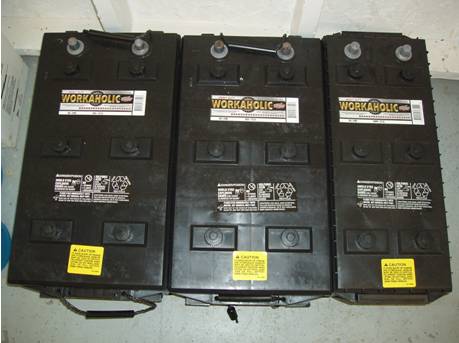
Maintenance they need? What do you need to do for your batteries to get the longest life from them? There are two types of batteries (well, there are lots of types of batteries) used mainly in the trucking industry, Deep Cycle and Starting. Deep cycle are designed to have a load put on them, be drawn down and recharged many times, golf car, RV, and boats use these. Starting batteries do just that, start things with very high loads for short periods, running a starter.
There are different versions of the same battery that will do the same job. They may be the same size and the posts may be in the same location, but inside they may be very different. The most common battery in trucks is the lead acid battery. Built in different styles such as the Wet Cell, the Gel Cell, and the Absorbed Glass Mat or AGM. The wet cell comes in two styles, maintenance free, and serviceable (removable caps), both are filled with electrolyte (acid), only the serviceable one can be checked and refilled if needed. The gel cell and the AGM batteries are specialty batteries that are more costly but do not tend to sulfate (go bad) as quickly as the wet cell battery. Between gel and AGM, the AGM seems to last longest, but they really don't like high temperatures or high discharge loads.
There are lots of letters on the top of a battery, CCA, CA, AH, and RC. What do they mean to you?
CCA, Cold Cranking Amps, This is the measurement of the number of amps a battery can deliver at 0 degrees F. and not drop below 7.2 volts. A high CCA battery is good in cold weather.
CA, Cranking Amps, The number of amps available at 32 degrees F.
RC, Reserve Capacity, This is the number of minutes a fully charged battery will discharge 25 amps at 80 degrees F. until the voltage drops below 10.5. This is a very important rating that is overlooked by most battery purchasers.
AH, Amp Hour, This rating tells you how many amps a battery will deliver for a certain period of time. If a battery has a rating of 100 AH, it should deliver 5 amps for 20 hours, or 20 amps for 5 hours, or 10 amps for 10 hours. This is usually a rating found on deep cycle batteries.
Before working on anything safety first. Remember we will be working with high amperage batteries, corrosive acid, and explosive gasses. No smoking or open flames, the gasses emitted from a battery are hydrogen gases, remember what happened to the Hindenburg, static electricity set it off. Remove all jewelry from arms and hands. Wear safety glasses and rubber or plastic gloves and wear overalls or an apron made of polyester or wool, electrolyte will eat cotton. Just the gasses from a charging battery condensing on metal parts can cause corrosion.
Safety gear on we're ready to begin. The batteries should be clean. The connections should be clean and tight. Many battery problems are caused by dirty and/or loose connections. If there is a master switch or battery cutoff switch turn it off now. For most of us with maintenance free batteries, just wash off, let dry, remove and clean each connection with a stiff plastic brush. Use good dielectrics grease under the cable and nut, tighten, turn on master switch and were done. It may be a good idea to do one cable at a time so we don't mix cable placement.
For those with serviceable batteries there’s a little more to it. Same as above clean, clean and tight connections, but we need to check electrolyte level. Remove the cell caps, some screw off some pop off, if they need filled do NOT use acid, use distilled water (no minerals in it), do not overfill reinstall caps and we're done.
For those with lead post connections, again clean, clean connections but before installing cables put a small bead of silicone around the bottom of the post. Install a felt battery washer over the silicone coat the washer with high temp grease or petroleum jelly, then install cables and tighten. Coat the entire connection with the grease, and again were done.
If you're having battery issues now, testing will be required. Maintenance free batteries need to be load tested, the tools are expensive and unless you have a fleet it’s not cost justifiable, take them to a shop for testing. Serviceable batteries use a temperature compensating hydrometer for testing, not to expensive and available at most parts stores. There is a procedure to follow; instructions should come with the hydrometer. The hydrometer measures specific gravity of the electrolyte, a chart that comes with the hydrometer will tell you the condition of the battery in question.
Is it replacement time now? Choosing the right battery can be confusing, I recommend a battery with the greatest AH or RC rating that is the same dimensions as the battery being replaced. Gel or AGM may be a good choice, as they tend to need less attention. Buy the battery for the job it needs to do. Some have a need for batteries that will do multiple jobs, start the truck and run the high loads from the sleeper. These dual-purpose batteries are a compromise of the starting and deep cycle batteries. They typically will have a shorter life, be more expensive and will not be as strong. However, they will do the job and are a better option than adding a set of batteries just for the sleeper. Ask your battery supplier for their advice, but make your own informed decisions.